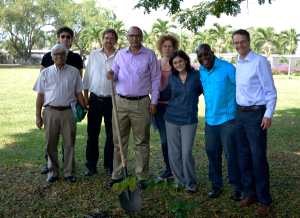 By Andrea Carvajal, originally posted at CIAT’s blog.
By Andrea Carvajal, originally posted at CIAT’s blog.
“It is known throughout the region that together we work well and we create synergies,” said Muhammad Ibrahim, new Director General of the Tropical Agricultural Research and Higher Education Center (CATIE, its Spanish acronym) during his visit to CIAT headquarters near Cali, Colombia, in July, identifying collaborative research areas. According to him, CIAT and CATIE, who are both members of the CGIAR Research Program on Forests, Trees and Agroforestry among others, should take advantage of their long-standing cooperation, which gives them credibility.
Ibrahim took office as CATIE Director General last 29 February for a period of four years and his good relationship with both Centers and the impact of his work are evidenced in concrete actions, such as the creation of CATIE’s Livestock and Environmental Management Program (GAMMA, its Spanish acronym).
“Today, the agenda on shared and complementary topics is even broader and more diverse, due to our common interest in issues such as climate-smart agriculture and climate change adaptation and mitigation strategies,” said Ibrahim, who sees CIAT’s Biotechnology Unit as a strategic partner to identify more varieties that are resistant to diseases and the effects of climate change, and that are capable of maintaining high yields, using the germplasm available in CATIE’s international coffee and cocoa collections.
“Now, as Director General, I also have in mind other issues that are key to CATIE research, as well as its role as a quality education entity. The goal is to promote a horizontal cooperation by exploring opportunities to work jointly in the development of technologies to impact livelihoods. This also means joint publications, efforts to inform policy making, project design and development, and resource mobilization plans, coupled with management indicators to reflect the changes we will have accomplished in five years time.” (Muhammad Ibrahim, General Director, CATIE)
Nicaragua as an entry point for innovation and sustainable development
Along with Bangladesh, Ethiopia, Nigeria, Tanzania, and Vietnam, Nicaragua is one of the so-called site integration countries, defined by the CGIAR System as meeting points to facilitate improved coordination among the different CGIAR Research Programs (CRPs) present in the region – especially now that the second phase, from 2017 to 2020, is about to start.
Among the various reasons for choosing Nicaragua is the fact that its agro-ecological and socio-economic characteristics are representative of the rest of Central American countries, which makes it possible for knowledge and innovations developed in this country to be scaled out to benefit producers from Belize, Costa Rica, El Salvador, Honduras, Guatemala, and Panama.

One of the CRPs present in Nicaragua is the program on Climate Change, Agriculture and Food Security (CCAFS), led by CIAT, for whom CATIE is a strategic partner with whom the Center has laid out the following vision:
For 2022, as a result of the CATIE-CCAFS collaboration, a variety of research inputs and key evidence will have been generated to enhance decision making in the Latin American agricultural sector at the local, national, and regional level, considering the effects and opportunities presented by a changing climate. Climate-Smart Territories (CST) and Climate-Smart Villages (CSV) have been scaled out to different locations within the region and are known to be hubs for the design of participatory methodologies, technology testing, and the development of community-based processes aimed to find portfolios of Climate-Smart Agriculture (CSA) practices and services that contribute to enhancing resilience, reducing emissions, and increasing food security through improved productivity.
This vision will become a reality through the implementation of a short-term collaborative strategy, in which the complementarity among CSTs and CSVs regarding climate change is as essential as the inclusion of a gender perspective, production of joint research publications, and coordination to support regional, national, and local stakeholders.
Therefore, there are four especially important key points to recover the so-called Central American dry corridor; “it is an opportunity to work in the region and capitalize on the learning experiences achieved by the CSTs and CSVs,” says Isabel Gutiérrez, CATIE liaison officer for Colombia.
This is how, by means of a renewed collaborative research agenda, both centers show their strong commitment to sustainable development in the Latin American region. A commitment that is also evidenced in other long-term endeavors in which CATIE and CIAT take an active part, such as the 20×20 Initiative, aimed to restore 20 million hectares of degraded land by 2020.











